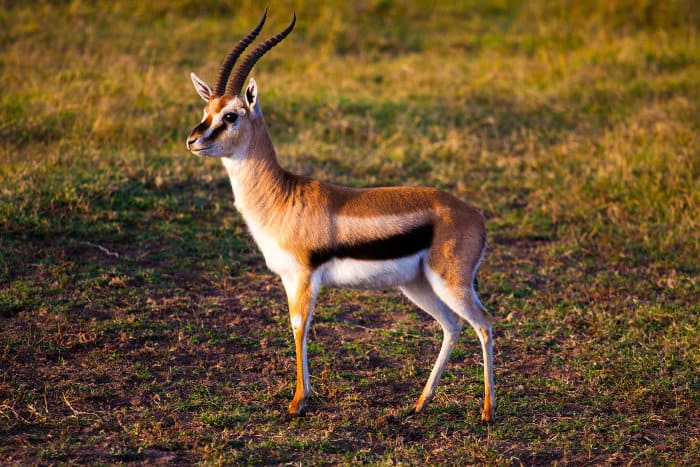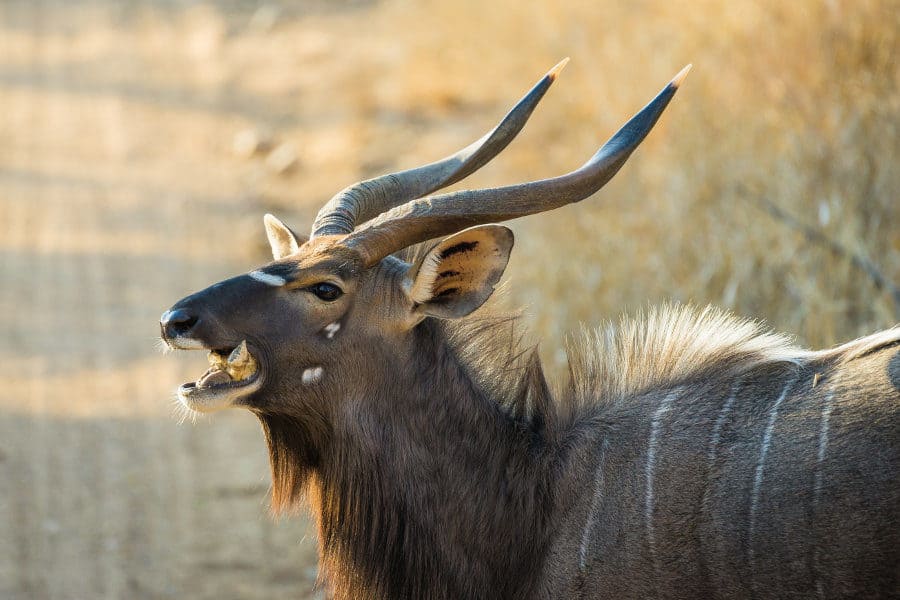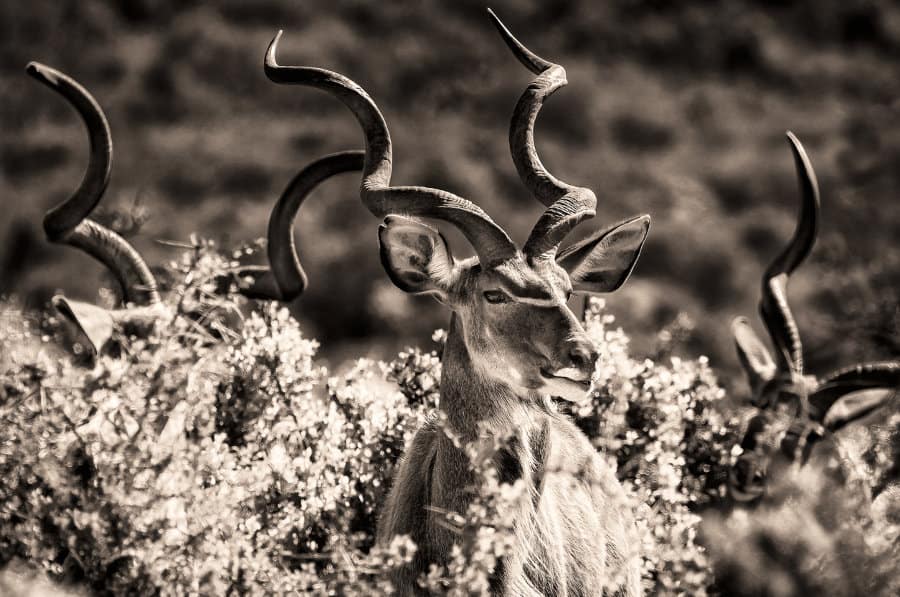The relationship between gazelles and antelopes is one of those slightly complicated deals. But we’re going to help make it less complicated.
Antelopes and gazelles belong to the bovid family – the same as cows and other cattle, sheep, and so on. They all have cloven hooves and horns to some degree.
Every bovid that is not a buffalo, bison and other domestic cattle like goat, sheep and cow, is an antelope. Even gazelles are antelopes, however not all antelopes are gazelles.
Are you still following?
Don’t worry, it’ll make sense soon.
So what is a gazelle, then?
Gazelles are a subclass of antelope, and here’s where we’ll look at how to tell the difference, what similarities they share, and what makes them so fascinating.
General Notes on the Antelope and Gazelle Species

For context, here’s a basic picture of the antelope situation on planet Earth:
- There are 91 species of antelope in the world.
- Antelopes are native to Africa and Asia, but also live in the Americas.
- Of the 91 species of antelope, 72 exist on the African continent.
- The gazelle family (genus Gazella) accounts for 19 of the 91 species of antelope.
- All antelopes (including gazelle) have a stomach with four chambers.
- All antelopes are ungulates – they have even-toed hooves.
Question: Is a gazelle a deer?
No. Antelope are not deer primarily because of their “horns”. Deer have antlers that shed every year, while antelope grow permanent horns.
The Main Difference Between Antelope and Gazelle
Let’s start with a few obvious ways to determine whether the bovid you’re looking at is an antelope, or more specifically, a gazelle.
The main visual indicator is antelope size comparison, with another possible way being the horns. Basically, a gazelle is smaller than most of the other antelope species.
A Thomson’s gazelle, a common gazelle in Africa, weighs around 30 kg. Compare that to blue wildebeest (180-250 kg), common eland, (up to 900+ kg) or tsessebe (110 kg) and you get the idea.
The second major difference is that in most gazelle species, both males and females have horns. In most other antelope species, only males have horns.
This is a less-reliable way of telling them apart, though, unless you know your antelope well.
Antelopes

When on safari in Africa, you’ll see plenty of examples of regal and elegant antelope in the wild. Oryx, wildebeest, eland and others are all large and plentiful.
Their sizes do range significantly, but in general, you’ll find that larger specimens will not be gazelle.
Gazelles
Species of gazelle look more elegant and streamlined than most larger antelope. They have incredible speed and grace and can do impressive leaps when moving through the brush.
They are quick – a lot quicker than most other antelopes, and have a particular action known as “stotting”.
Stotting involves an impressive leap with all four hooves leaving the ground. The gazelle will rise up in the air with an arched back, its legs out straight.
This is usually a reaction to a threat, and part of a getaway action. It is truly impressive to see.
Only gazelle stot, and not other antelope.
Side-fact: Some non-gazelle antelope can jump, though it is not considered stotting. The impala, for example, can jump an impressive 3 m high, and travel a distance of 9 m with such a jump.
The diminutive klipspringer – one of the smallest antelopes – is only 60 cm tall, but can jump almost 4 m in height (some claim up to 7 m, but that’s in dispute).
The 19 different types of gazelles

As mentioned, there are 19 recognised Asian, American or African gazelle types within the genus.
- Thomson’s gazelle
- Speke’s gazelle
- Soemmerring’s gazelle
- Saudi gazelle
- Rhim gazelle
- Red gazelle
- Red-fronted gazelle
- Mountain gazelle
- Mongalla gazelle
- Heuglin’s gazelle
- Grant’s gazelle
- Goitered gazelle
- Erlanger’s gazelle
- Dorcas gazelle
- Dama gazelle
- Cuvier’s gazelle
- Chinkara or Indian gazelle
- Arabian sand gazelle
- Arabian gazelle
Gazelle vs Antelope Appearance
The range of antelope species makes it complicated to use a general description.
Here are a few aspects of gazelle and antelope appearances that keen-eyed viewers might observe.
Colour

Antelopes are commonly brown and white. But there are several types that range between grey and dark grey, some with stripes or a white face.
Gazelles, on the other hand, are more often tan. They also have white sections, usually the underside or rump, and a dark stripe along the body.
The white rump is significant, as it is an important tool when gazelles are escaping from a predator.
When a gazelle is stotting or bolting from a predator, others in the herd seem to follow the action of the individual ahead of them.
The white rump may be the visual cue for evasive action. This is why you will see the gazelle jumping at the same point and time the one ahead of it does.
Size
Antelopes can grow very large. On average, they can stand as much as 1.5 metres. That said, the range in size is huge, with eland weighing almost a ton, while others – like the royal antelope – as little as 3 kg.
As mentioned, gazelles are on the smaller end of the antelope scale. They typically grow to around a metre high, and seldom tip the scales at much more than 30 kg.
Horns

All antelope horns are hollow. They are also permanent.
Not all antelopes have horns – in most species, only the males develop them. On the other hand, both males and females develop horns in the gazelle species.
Antelope horns come in a variety of shapes and sizes. Some have spiralled horns, some have rings, are S-shaped, or even lyre-shaped. The amazing greater kudu antelope horn is huge and spiralled.
Gazelle horns curve backwards, are very sharp and have distinctive rings. Male horns are generally bigger than female horns.
Body shape
Gazelles have slender legs and bodies. They seem athletic and light in comparison to other members of the antelope family.
Many other antelope have large, bulky bodies and large heads. They don’t seem like animals that can jump and move quickly.
Don’t fool yourself. Most antelopes can move at a frightening pace – even the big ones.
Gazelle and Antelope Habitats

So, do gazelles have a particular preference for living space over other antelopes? Let’s find out.
Where do they live?
Wild antelopes live fairly broadly across most habitats from Asia through the Middle East and especially in Africa.
Chances are, there’s an antelope wherever conditions allow. Humans have occasionally displaced them, due to urbanisation and loss of habitat.
Gazelles, being smaller and generally more skittish of interference, are also fairly widespread.
They often share habitats with larger antelopes, as they have a somewhat symbiotic relationship with food. Gazelles eat shorter grass than the larger antelope.
Most gazelle do prefer open lands and savannas, although the Edmi (also known as Cuvier’s) gazelle lives in the mountains. Maybe it enjoys the solitude.
Food & Diet

Leaves and grass form the basis of both antelope and gazelle diets. It’s also a major source of hydration.
In the dry desert regions, water isn’t always available. Leaves and grass make for useful substitutes.
A Few Odd Behaviours and Facts
If you thought antelopes and gazelles were boring, you’d be wrong.
They have a couple of odd behaviours that make for intriguing discussion.
- Antelopes follow zebras for food. Sometimes you may find antelopes hanging around zebras. It turns out that zebras graze on tough grass, leaving softer, shorter grass for those that follow… in this case, antelopes.
- Some antelopes hide their babies in long grass away from the herd, at least until they are old enough to run well.
- We’ve mentioned stotting. Only gazelle stot. Other antelope will run, and some may even turn on predators or other danger and charge at it.
- Certain antelope leave scented tracks with their hooves. If one separates from a herd, it can find its way back by this scent.
Antelope and Gazelle Speed Comparisons

Generally, gazelles are faster than antelopes. That said, the pronghorn antelope – an American antelope and not technically a gazelle – clocks in at 98 kmph.
Springbok, tsessebe, wildebeest and Thomson’s gazelle are also among the fastest antelope, all well over or around 80 kmph.
Are Gazelle or Antelope Endangered?
Sadly, nearly one-quarter of all antelopes are endangered today, according to the IUCN Red List of Threatened Species.
Gazelles, therefore, are also showing declines in populations due to hunting and habitat loss.
Of the most endangered, these are the top five:
- Addax (Addax nasomaculatus).
- Aders’s duiker (Cephalophus adersi)
- Dama gazelle (Nanger dama)
- Hirola (Beatragus hunteri)
- Saiga antelope (Saiga tatarica)
Springbok is the only antelope showing a trend with a long-term increase in population.
Thanks to active programs across the African continent, hope remains for the reintroduction and preservation of some of the most endangered antelopes.
Visit Africa to Experience Antelope and Gazelle

As with all wildlife, the best way to experience antelope and gazelle is in their natural habitat.
Why not book an African safari and tick off as many antelope as you can?
They aren’t that hard to find and are especially gorgeous in the African sun.




Could you please just clarify for me if a buffalo is an antelope? You mention up front “Every bovid that is not a buffalo, bison and other domestic cattle like goat, sheep and cow, is an antelope”, then later on you include buffalo in the following: “When on safari in Africa, you’ll see plenty of examples of regal and elegant antelope in the wild. Oryx, wildebeest, buffalo, eland and others are all large and plentiful.” And they also get a mention under “A Few Odd Behaviours and Facts” which are about antelope. Otherwise, great article, though admittedly I’ve found that all of your articles are great!
Hi Richard,
Thanks for your comment.
While antelope and buffalo are both part of the same Bovidae family, a buffalo is not an antelope per se, no!
But a wildebeest apparently is (go figure why)! 😉 Those classifications can be confusing.
You’re right that some of the details are a little misleading. I will make some slight adjustments accordingly.
Glad you find the content useful otherwise.
Have a blessed weekend,
Michael